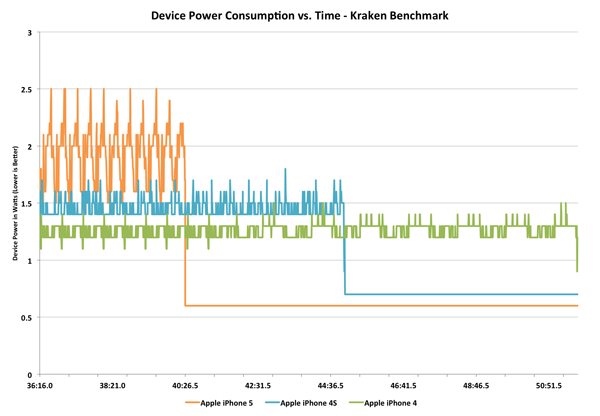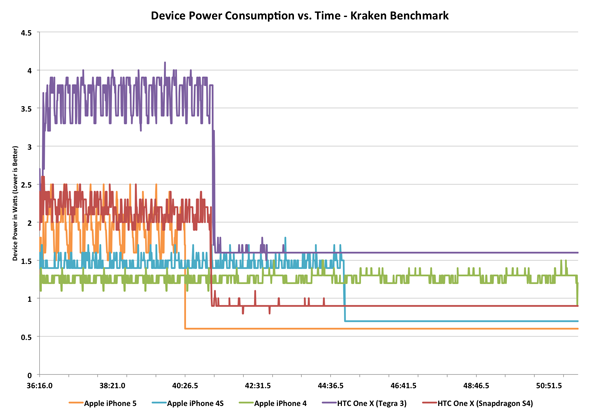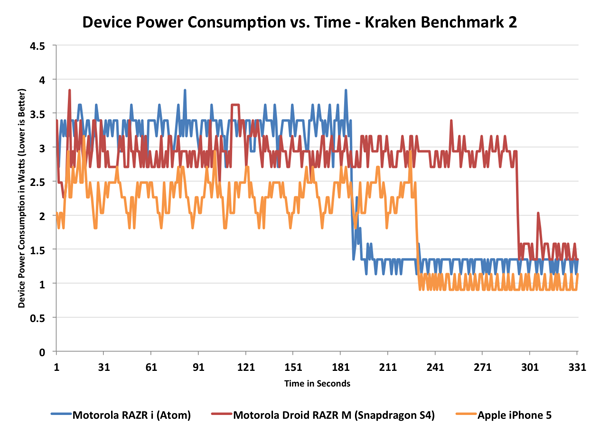The iPhone 5 Review
by Anand Lal Shimpi, Brian Klug & Vivek Gowri on October 16, 2012 11:33 AM EST- Posted in
- Smartphones
- Apple
- Mobile
- iPhone 5
Increased Dynamic Range: Understanding the Power Profile of Modern SoCs
Section by Anand Shimpi
The iPhone 4S greatly complicated the matter of smartphone power consumption. With the A5 SoC Apple introduced a much wider dynamic range of power consumption to the iPhone than we were previously used to. Depending on the workload, the A5 SoC could either use much more power than its predecessor or enjoy decreased overall energy usage. I began our battery life analysis last time with some graphs showing the power savings realized by a more power hungry, faster CPU.
The iPhone 5 doesn't simplify things any more. I believe the days of us having straightforward discussions about better/worse battery life are long gone. We are now firmly in the era of expanded dynamic range when it comes to smartphone power consumption. What do I mean by that? The best way to explain is to look at some data. The graphs below show total device power consumption over time for a handful of devices running the Mozilla Kraken javascript benchmark. Kraken is multithreaded and hits the CPU cores fairly well. The power profile of the benchmark ends up being very similar to loading a very js-heavy web page, although for a longer period of time. All of the device displays were calibrated to 200 nits, although obviously larger displays can consume more power.
Let's start out by just looking at the three most recent iPhone generations:
The timescale for this chart is just how long the iPhone 4 takes to complete the Kraken benchmark. The iPhone 4/4S performance gap feels a lot bigger now going back to the 4 than it did when the 4S launched, but that's how it usually seems to work. Note how tight the swings are between min and max power consumption on the iPhone 4 during the test. As a standalone device you might view the iPhone 4 as being fairly variable when it comes to power consumption but compared to the 4S and 5 it might as well be a straight line.
The 4S complicated things by consuming tangibly more power under load than the 4, but being fast enough to complete tasks in appreciably less time. In the case of this Kraken run, the 4S consumes more power than the 4, however it's able to go to sleep quicker than the 4 and thus draw less power. If we extended the timeline for the iPhone 4 significantly beyond the end of its benchmark run we'd see the 4S eventually come out ahead in battery life as it was able to race to sleep quicker. The reality is that with more performance comes increased device usage - in other words, it's highly unlikely that with a 50% gain in performance users are simply going to continue to use their smartphone the same way as they would a slower device. Usage (and thus workload) doesn't remain constant, it's somewhat related to response time.
The iPhone 5 brings new meaning to device level power consumption. With a larger display and much more powerful CPU, it can easily draw 33% more power than the 4S under load, on average. Note the big swings in power consumption during the test. The A6 SoC appears to be more aggressive in transitioning down to idle states than any previous Apple SoC, which makes sense given how much higher its peak power consumption can be. Looking at total energy consumed however, the iPhone 5 clearly has the ability to be more power efficient on battery. The 5 drops down to iPhone 4 levels of idle power consumption in roughly half the time of the iPhone 4S. Given the same workload that doesn't run indefinitely (or nearly indefinitely), the iPhone 5 will outlast the iPhone 4S on a single charge. Keep the device pegged however and it will die quicker.
Out of curiosity I wanted to toss in a couple of other devices based on NVIDIA and Qualcomm silicon to see how things change. I grabbed both versions of the HTC One X:
The Tegra 3 based One X actually performs very well in this test, but its peak power consumption is significantly worse than everything else. It makes sense given the many ARM Cortex A9 cores built on a 40nm G process running at high clock speeds on the Tegra 3.
The 28nm Snapdragon S4 (dual-core Krait) based One X gives us some very interesting results. Peak power consumption looks identical to the iPhone 5, however Apple is able to go into deeper sleep states than HTC can with its S4 platform. Performance is a little worse here but that could be a combination of SoC and software/browser. I used Chrome for all of the tests so it should be putting Android's best foot forward, but the latest update to Safari in iOS 6 really did boost javascript performance to almost untouchable levels.
At the end of the day, the power profile of the iPhone 5 appears to be very close to that of a modern Snapdragon S4 based Android smartphone. Any battery life gains that Apple sees are strictly as a result of software optimizations that lead to better performance or the ability to push aggressively to lower idle power states (or both). It shouldn't be very surprising that these sound like a lot of the same advantages Apple has when talking about Mac battery life as well. Don't let the CPU cores go to sleep and Apple behaves similarly to other device vendors, but it's really in idle time or periods of lighter usage that Apple is able to make up a lot of ground.
There's one member of the modern mobile SoC market that we haven't looked at thus far: Intel's Medfield. The data below isn't directly comparable to the data above, my measurement methods were a little different but the idea is similar - we're looking at device level power consumption over time while Kraken runs. Here I'm only focusing on the latest and greatest, the Atom based Motorola RAZR i, the Snapdragon S4 based Droid RAZR M and the iPhone 5. The RAZR i/M are nearly identical devices making this the perfect power profile comparison of Atom vs. Snapdragon S4. The RAZR i is also the first Atom Z2460 based part to turbo up to 2.0GHz.
Very interesting. Atom is the only CPU that can complete the Kraken benchmark in less time than Apple's Swift. Peak power consumption is definitely higher than both the Qualcomm and Apple devices, although Intel's philosophy is likely that the added power usage is worth it given the quicker transition to idle. Note that Atom is able to drive to a slightly lower idle level than the Snapdragon S4, although the Swift based iPhone 5 can still go lower.
At least based on this data, it looks like Intel is the closest to offering a real competitor to Apple's own platform from a power efficiency standpoint. We're a couple quarters away from seeing the next generation of mobile SoCs so anything can happen next round, but I can't stress enough that the x86 power myth has been busted at this point.
I will add that despite Intel's performance advantage here, I'm not sure it justifies the additional peak power consumption. The RAZR i ends up being faster than the iPhone 5 but it draws substantially more power in doing so, and the time savings may not necessarily offset that. We'll see what happens when we get to our battery life tests.













276 Comments
View All Comments
rarson - Wednesday, October 17, 2012 - link
Car bumpers are not made of aluminum.Aluminum oxidizes. So if you scratch it, then you've removed that oxidation layer to allow it to further oxidize at that spot. Rust is just iron oxidation.
Spunjji - Friday, October 19, 2012 - link
It is not normal for them to scratch so damn easily. Furthermore, you might notice that other manufacturers (say, HTC?) take steps to harden the surfaces of their devices to avoid this kind of problem.name99 - Wednesday, October 17, 2012 - link
So you're basically(a) upset that Apple fans buy products based on how they look
(b) upset that Apple fans's don't care enough about how products look to care about this
???
The true sign of the demented mind --- that it can happily hold two contradictory opinions at once.
steven75 - Wednesday, October 17, 2012 - link
Would you buy a car that gets nicks and scratches from normal usage?Um yes, everyone does. I guess all cars should be recalled!
Spunjji - Friday, October 19, 2012 - link
Would you buy a car that gets nicks and scratches from simply driving down the street? No, you wouldn't. Stop distorting the argument for an easy victory, it makes for extremely aggravating reading.doobydoo - Saturday, October 20, 2012 - link
And what evidence do you have that the equivalent of 'driving down the street' with an iPhone causes scratching?ltcommanderdata - Tuesday, October 16, 2012 - link
Any final MHz rating on the GPU? Given Apple tends to use a 4:1 clock speed ratio between the CPU and GPU, the SGX543MP3 being up to 325MHz would make sense. The SGX543MP2 seemed to be clocked at 200MHz in the iPhone 4S and 250MHz in the iPad 2 and Apple said the iPad 2012 has a 2x faster GPU, so the SGX543MP4 in the A5X likely is also at 250MHz. A SGX543MP3 at 325MHz vs a SGX543MP4 at 250MHz would seem to explain the results seen in the benchmarks.A few corrections, on page 11 the GLBenchmark 2.5 - Triangle Texture Test - Fragment Lit (Offscreen 180p) is missing the iPad 2012 result.
In iPhone 5 Device Conclusions on page 22, you write "Going back to the old 4:3 aspect ratio iPhones feels extremely claustrophobic now", but it should be 3:2.
daar - Tuesday, October 16, 2012 - link
The in-depth tech info was nice, but would have preferred it in a second post. As an engineer, while I can appreciate the advances made with the new SoC and the depth of the effort went into researching all the aspects of the phone, I also think for most purposes, the length is counterproductive when the majority of readers are looking for indicators of whether the phone is worth an upgrade. Even without the tech explanation though, the review unnaturally lacked the concise detail I'm used to at AT.In some ways, it sort of came across that the tech explanation was a long worded way of making excuses for the iPhone 5's faults and direct comparisons to superior implementations were ignored. Simple example would be the camera, where praise was given about how they cut the size, that it looked good, explanation of the purple tint and so forth. If say, Samsung had released a phone with such issues, I'd expect the review to mention the sloppiness of it, esp with rivals such as the One X having a 2.0f lens (I quite enjoyed the One X/SG3 review comparison from AT). The excuse that the lack of innovation in the new iOS being that the aim of the phone is like that of an appliance whereas Android phones aiming to be PC's is baffling; the concept of a smartphone was a versatile device to aid in our daily lives not reach a point of some ambiguity called an appliance.
darwinosx - Tuesday, October 16, 2012 - link
That was a lot of words to say nothing besides bragging that you are an engineer. Nobody cares.kyuu - Tuesday, October 16, 2012 - link
What nobody cares about are your rabid attacks on any comment that has even the slightest critique of an Apple product.